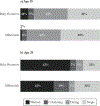Young Adulthood Relationships in an Era of Uncertainty: A Case for Cohabitation
- PMID: 32430891
- PMCID: PMC11335140
- DOI: 10.1007/s13524-020-00881-9
Young Adulthood Relationships in an Era of Uncertainty: A Case for Cohabitation
Abstract
The young adulthood years are demographically dense. Dr. Ronald Rindfuss made this claim when he was Population Association of America (PAA) president in 1991 (Rindfuss 1991), and this conclusion holds today. I offer both an update of his work by including Millennials and a new view on young adulthood by focusing on an increasingly common experience: cohabitation. I believe we need to move away from our marriage-centric lens of young adulthood and embrace the complexity that cohabitation offers. The cohabitation boom is continuing with no evidence of a slowdown. Young adults are experiencing complex relationship biographies, and social science research is struggling to keep pace. Increasingly, there is a decoupling of cohabitation and marriage, suggesting new ways of framing our understanding of relationships in young adulthood. As a field, we can do better to ensure that our theories, methods, and data collections better reflect the new relationship reality faced by young adults.
Keywords: Cohabitation; Cohorts; Family; Marriage; Measurement.
Figures







Similar articles
-
Young Adults' Perceived Purposes of Emerging Adulthood: Implications for Cohabitation.J Psychol. 2016;150(4):485-501. doi: 10.1080/00223980.2015.1099513. Epub 2015 Dec 8. J Psychol. 2016. PMID: 26645897
-
Cohabitation, post-conception unions, and the rise in nonmarital fertility.Soc Sci Res. 2014 Sep;47:134-47. doi: 10.1016/j.ssresearch.2014.04.002. Epub 2014 Apr 22. Soc Sci Res. 2014. PMID: 24913950 Free PMC article.
-
A Cohort Comparison of Predictors of Young Adult Union Formation and Dissolution in the US.Adv Life Course Res. 2018 Dec;38:37-49. doi: 10.1016/j.alcr.2018.09.001. Epub 2018 Sep 15. Adv Life Course Res. 2018. PMID: 31680789 Free PMC article.
-
Understanding U.S. fertility: continuity and change in the National Survey of Family Growth, 1988-1995.Fam Plann Perspect. 1996 Jan-Feb;28(1):4-12. Fam Plann Perspect. 1996. PMID: 8822409 Review.
-
Union and Family Formation During Young Adulthood: Insights From the Add Health.J Adolesc Health. 2022 Dec;71(6S):S32-S39. doi: 10.1016/j.jadohealth.2022.06.020. J Adolesc Health. 2022. PMID: 36404017 Free PMC article. Review.
Cited by
-
Age 19-30 Union Formation Trajectories across the Past 30 Years within the U.S.: Delineating Heterogeneity in Trajectories and its Historical and Sociodemographic Variation.Res Hum Dev. 2024;21(1):26-49. doi: 10.1080/15427609.2024.2366110. Epub 2024 Jun 24. Res Hum Dev. 2024. PMID: 39036538 Free PMC article.
-
A Brief Report Comparing Younger and Older Cohabitors.J Marriage Fam. 2025 Jun 12:10.1111/jomf.13128. doi: 10.1111/jomf.13128. Online ahead of print. J Marriage Fam. 2025. PMID: 40857534
-
Millennials as a Demographic Bridge to Diversity? Segregation and Diversity of Young Adult Neighborhoods.Popul Res Policy Rev. 2025;44(3):32. doi: 10.1007/s11113-025-09954-2. Epub 2025 May 12. Popul Res Policy Rev. 2025. PMID: 40370488 Free PMC article.
-
Women's Divergent Union Transitions After Marital Dissolution in the United States.Popul Res Policy Rev. 2022 Jun;41(3):953-980. doi: 10.1007/s11113-021-09677-0. Epub 2021 Aug 25. Popul Res Policy Rev. 2022. PMID: 37501662 Free PMC article.
-
Race and ethnic differences in step- versus biological parent support to adult children.J Marriage Fam. 2024 Aug;86(4):1119-1131. doi: 10.1111/jomf.12994. Epub 2024 Apr 26. J Marriage Fam. 2024. PMID: 39239381 Free PMC article.
References
-
- Allred C. (2019a). High school seniors’ attitudes toward cohabitation as a testing ground for marriage, 2017 (Family Profile No. FP-19–10). Bowling Green, OH: National Center for Family & Marriage Research, Bowling Green State University. 10.25035/ncfmr/fp-19-10 - DOI
-
- Allred C. (2019b). High school seniors’ expectations to marry, 2017 (Family Profile No. FP-19–11). Bowling Green, OH: National Center for Family & Marriage Research, Bowling Green State University. 10.25035/ncfmr/fp-19-11 - DOI
-
- Allred C. (2019c). Age variation in the divorce rate, 1990 & 2017 (Family Profile FP-19–13). Bowling Green, OH: National Center for Family & Marriage Research, Bowling Green State University. 10.25035/ncfmr/fp-19-13 - DOI
-
- Amato P. (2014). Marriage, cohabitation and mental health. Family Matters, 96, 5–13.
-
- Arnett JJ (2000). Emerging adulthood: A theory of development from the late teens through the twenties. American Psychologist, 55, 469–480. - PubMed
Publication types
MeSH terms
Grants and funding
LinkOut - more resources
Full Text Sources
Research Materials

